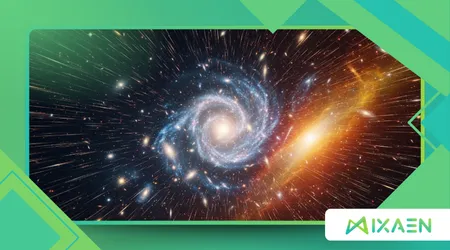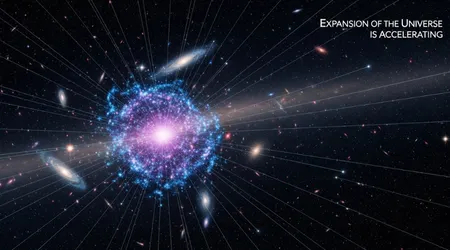Why the Expansion of the Universe Is Accelerating Without Clear Cause

The Expansion of the Universe Is Accelerating Without Clear Cause remains the most profound enigma facing modern physics, a cosmic mystery that challenges our fundamental understanding of reality itself.
Anúncios
We stand today, in late 2025, at a precipice of discovery. Recent findings from the world’s most sophisticated cosmological surveys hint at an evolving universe, making the central question of this acceleration more dynamic and pressing than ever before.
In 1998, two independent teams the Supernova Cosmology Project and the High-Z Supernova Search Team made a Nobel Prize-winning discovery.
They observed distant Type Ia supernovae, finding them fainter than expected, a stunning revelation that the expansion of space was actually speeding up, not slowing down due to gravity.
This completely upended the prevailing cosmological models. This acceleration implies the existence of a mysterious, pervasive force with negative pressure, a gravitational repulsion we simply dubbed “dark energy.” The implications are staggering.
Anúncios
This unknown entity, dark energy, now constitutes the majority of the universe’s total energy budget. Its existence demands a revision of Einstein’s General Relativity or the introduction of new fundamental physics.
Understanding the source of this expansion is not merely an academic exercise; it dictates the ultimate fate of the cosmos itself.
Why Was the Discovery of Acceleration So Unexpected?
For decades, theoretical models assumed the universe, though expanding since the Big Bang, would slow down due to the combined gravitational pull of all its matter.
The discovery of the accelerating expansion was comparable to tossing an apple into the air and watching it shoot skyward faster and faster.
How Did Cosmologists Initially Predict the Fate of the Universe?
Before 1998, the cosmic fate depended solely on the density of matter. A dense universe would eventually collapse in a “Big Crunch.”
A less dense one would expand forever, gradually fading into a “Big Freeze.” Gravity was the only force considered to shape the universe’s ultimate destiny.
The unexpected faintness of distant supernovae our “standard candles” showed galaxies receding from us much faster than gravity alone permitted.
This observational data forced physicists to introduce a repulsive force into the equations, resurrecting Einstein’s long-discarded “Cosmological Constant” as the leading candidate for dark energy.
The Expansion of the Universe Is Accelerating Without Clear Cause truly represents a paradigm shift.
++ Could There Be Stars Made of Antimatter?
What Is the Role of Type Ia Supernovae in This Measurement?
Type Ia supernovae are vital because they serve as ‘standard candles,’ exploding with a consistent peak brightness.
By comparing their observed brightness to their known intrinsic luminosity, astronomers can calculate their distance.
Simultaneously, measuring the redshift of the light reveals the expansion rate of the space between us and the supernova.
The 1998 data showed distant supernovae were dimmer (and therefore farther away) than predicted by models that only included decelerating gravity, proving the Expansion of the Universe Is Accelerating Without Clear Cause.

What Do We Know About the Composition of the Cosmos Today?
CDM (Lambda-Cold Dark Matter), provides the best current fit for all observational data, but it leaves us with an extremely humbling cosmic inventory.
The visible, normal matter everything we see, touch, and study comprises only a tiny fraction of the total.
Also read: Are We Missing 95% of What the Universe Is Made Of?
Why Does Dark Energy Dominate the Cosmic Inventory?
Current data from the Planck mission and other major surveys reveal a universe overwhelmingly dominated by invisible components.
Normal (baryonic) matter, which forms stars and galaxies, makes up only about 5% of the total energy density.
Dark Matter, which provides the gravitational scaffolding for galaxies, accounts for about 26.8%. The remaining, baffling majority is Dark Energy.
This immense percentage approximately 68.2% is the cosmic fuel driving the current acceleration. The energy density of dark matter decreases as space expands, but the density of dark energy remains essentially constant, leading to its growing dominance over cosmic time.
The table below illustrates this startling reality, showing the stark contrast between what is known and what remains mysterious:
| Cosmic Component | Estimated Percentage of Total Energy Density | Role in the Universe |
| Dark Energy | Repulsive force; causes accelerating expansion | |
| Dark Matter | Attractive force; provides gravitational structure | |
| Normal (Baryonic) Matter | Stars, planets, gas, and all visible matter |
How is Our Universe’s Fate Tied to Dark Energy’s Nature?
CDM model assumes dark energy is the Cosmological Constant, , meaning its density never changes.
If true, the Expansion of the Universe Is Accelerating Without Clear Cause continues indefinitely, leading to a “Big Freeze” where all galaxies outside our local group recede faster than the speed of light, eventually leaving a cold, empty cosmos.
However, recent data from the Dark Energy Spectroscopic Instrument (DESI) hints at a potentially evolving, or dynamical, dark energy.
If this force is indeed weakening over time, as some calculations suggest, the ultimate fate of the universe could be dramatically different, possibly even leading to a reversal and a “Big Crunch.” The stakes could not be higher.
Read more: Frozen water around young sun-like stars: A sign of planet formation and potential habitability
What are the Leading Theoretical Explanations for Dark Energy?
The absence of a clear physical explanation for this repulsive force means cosmologists are exploring a range of possibilities, from the simplest solution to radical new physics.
What is the Cosmological Constant?
The simplest, mathematically elegant explanation is the Cosmological Constant, an intrinsic, uniform energy density of empty space itself.
As the universe expands, more space is created, and thus more dark energy appears, maintaining a constant density and driving the accelerating expansion.
This constant energy is equivalent to a vacuum energy, but here’s the enormous problem: quantum field theory predicts a vacuum energy density vastly by a factor of larger than the observed value.
This difference is arguably the largest discrepancy between theory and observation in the history of science, demonstrating why the Expansion of the Universe Is Accelerating Without Clear Cause is such a headache for physicists.
Why is ‘Quintessence’ a Popular Alternative Theory?
A competing idea is ‘Quintessence,’ which posits dark energy is a dynamic, evolving energy field, not a static constant.
This field changes its density and repulsive strength over time and space, potentially accounting for the hints of an evolving dark energy seen in new data. It introduces a new particle or force, a “fifth element,” beyond the four known fundamental forces.
Quintessence is a variable engine that might start strong, but its fuel (the dynamic field) gets weaker or stronger depending on its interaction with the expanding cosmos. The DESI hints suggest our engine might be sputtering, favoring the Quintessence model.
Could Modified Gravity Solve the Mystery?
Another radical approach skips dark energy altogether, suggesting that General Relativity itself breaks down on cosmic scales.
Instead of invoking a new energy, these modified gravity theories propose that the gravitational force simply changes its behavior over vast distances, manifesting as a repulsive force that simulates acceleration.
Imagine an ant walking on a massive rubber sheet (spacetime). On a small, local area, its movements perfectly obey the rules of the sheet.
But when the ant walks across the entire, enormous sheet, the sheer size makes the sheet behave in unexpected, warped ways that we misinterpret as a new, repulsive ant-pushing force.
This challenges us to ask: Are we seeing a new energy, or simply a breakdown of our gravitational rulebook?
What Does the Latest Research from 2025 Suggest?
The sheer scale of recent cosmological projects is beginning to provide the high-precision data needed to distinguish between the static Cosmological Constant and dynamic, evolving models.
What is the Significance of the DESI Results?
In mid-2025, the Dark Energy Spectroscopic Instrument (DESI) released its most detailed 3D map of the universe.
The results, while not conclusive, have strengthened hints that dark energy’s influence might be evolving over time.
This ongoing, real-time data analysis is central to understanding the Expansion of the Universe Is Accelerating Without Clear Cause.
Why Does the Hubble Tension Factor Into the Dark Energy Debate?
The ‘Hubble Tension’a significant mismatch between the expansion rate of the local universe and the rate extrapolated from early universe measurements (like the Cosmic Microwave Background) further complicates the picture.
Some theoretical models, like those involving dynamical dark energy or exotic new particles, attempt to resolve this tension by suggesting a period of enhanced expansion in the early universe, linking the dark energy mystery to the Hubble discrepancy. This demonstrates the interlinked nature of modern cosmic puzzles.
The Expansion of the Universe Is Accelerating Without Clear Cause is like a detective case where the only clue is a massive ship moving against the wind with no sails, no engine, and no current.
We see the effect (the acceleration), but we cannot locate the invisible force (dark energy) causing it. The DESI and Planck data are the fingerprint analysis, slowly eliminating suspects and refining our search for the culprit.
Conclusion: The Ultimate Destiny of the Cosmos
The mystery of the Expansion of the Universe Is Accelerating Without Clear Cause represents the frontier of 21st-century science.
Over 95% of the cosmos remains fundamentally unknown to us, dominated by dark matter and the even more perplexing dark energy.
The journey from the surprising 1998 supernova data to the dynamic dark energy hints of 2025 shows cosmology is in a state of revolutionary upheaval.
Whether dark energy is the constant vacuum energy, a variable field like Quintessence, or a sign that we must revise gravity, the answer holds the key to the universe’s beginning, its present state, and its inevitable end.
How do you think the current generation of scientists will finally crack the code of dark energy? Share your thoughts and theories on the ultimate fate of the cosmos in the comments below.
Frequently Asked Questions (FAQ)
Does the accelerating expansion mean we will eventually collide with other galaxies faster?
No. Gravity still dominates locally. Our Local Group of galaxies (Milky Way and Andromeda) remains gravitationally bound and will eventually merge.
The accelerating expansion only affects objects not bound by gravity, meaning distant galaxy clusters, which are receding faster and faster.
Why do we call it “dark” energy and not something more specific?
The term “dark energy” simply names the phenomenon we observe the accelerating expansion without assuming its physical nature.
It is “dark” because it does not interact with light (electromagnetic radiation), making it invisible to telescopes, much like “dark matter.”
Is dark energy related to black holes or quantum foam?
The standard model treats dark energy as a smooth, uniform component. However, some unconventional models, such as the “Coupling Constant Black Holes” (CCBH) hypothesis, propose a link between dark energy and the life cycles of black holes.
The idea of vacuum energy connects it loosely to the “quantum foam” of virtual particles, but the enormous magnitude mismatch remains unsolved.
Could the accelerated expansion stop or reverse itself?
The CDM model predicts the acceleration will continue forever.
However, if dark energy is dynamical (like Quintessence) and its repulsive force weakens over cosmic time, the universe could eventually slow down, halt, and even collapse in a “Big Crunch,” a fate suggested by some very recent, high-level theoretical calculations in late 2025.
